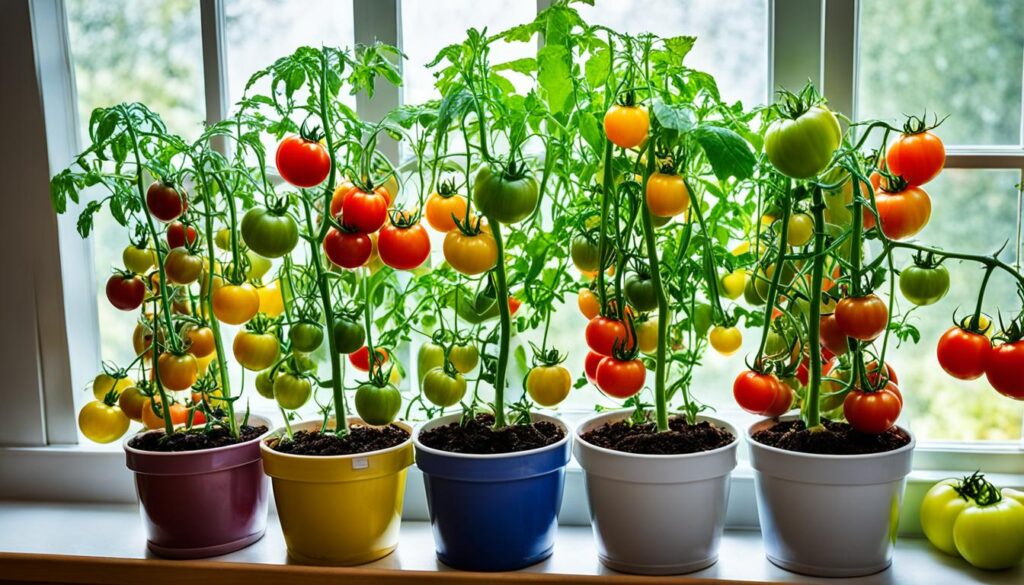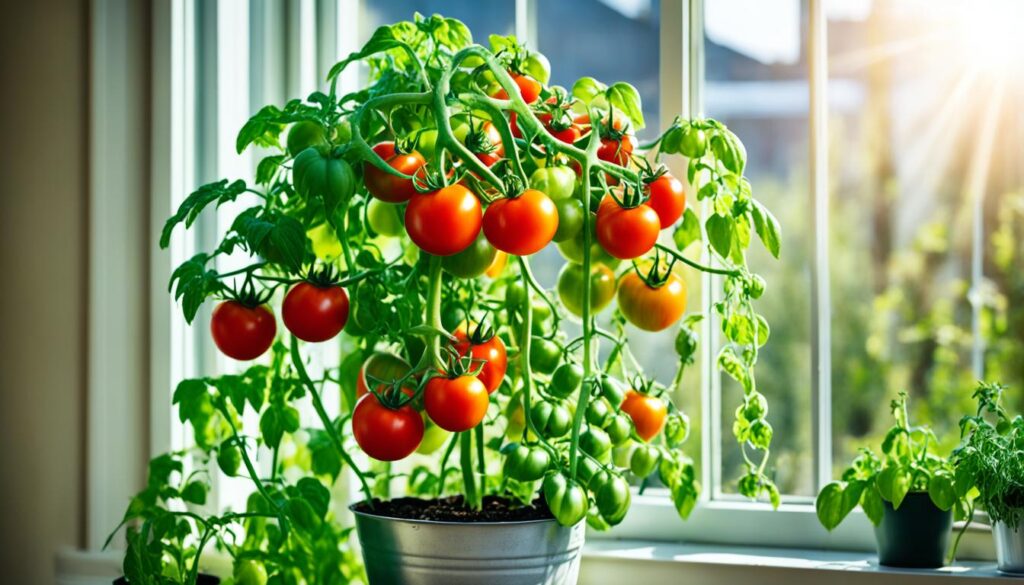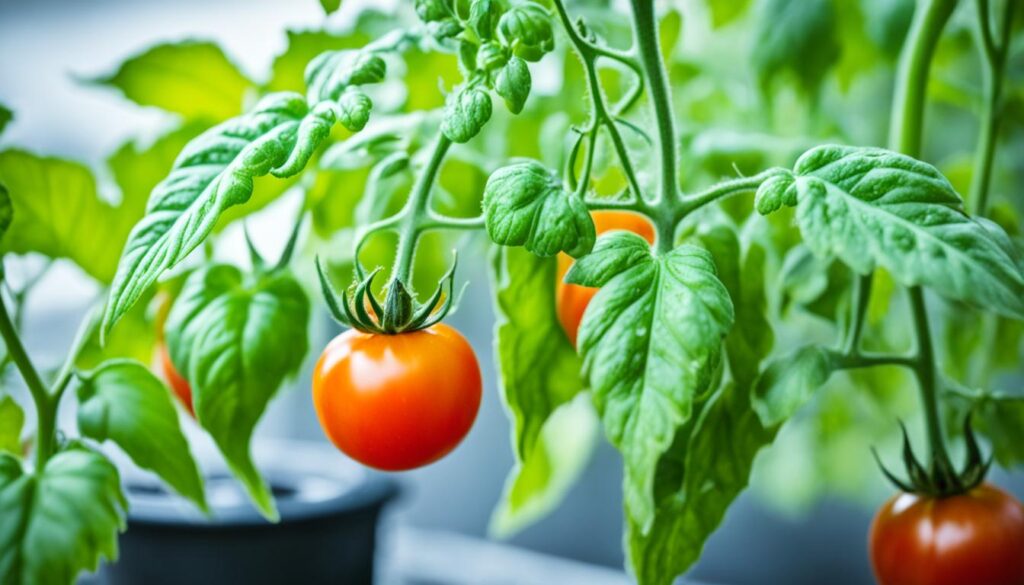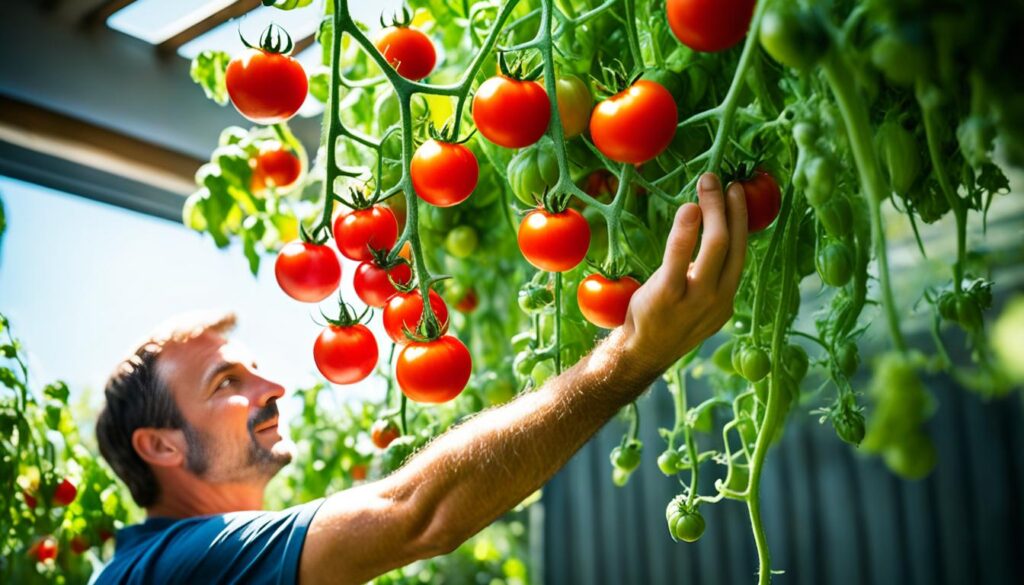Growing season’s pause doesn’t mean you can’t have fresh tomatoes. Indoor temperatures are perfect even when it’s cold outside. You’ll need the right tools and plenty of sunlight to fill your space with delicious tomatoes. This guide covers all you need to know, from beginning to harvest, ensuring a fruitful indoor gardening experience.
Key Takeaways
- Tomato seedlings and young plants require about 18 to 22 hours of supplemental light per day when growing indoors1
- Patio or bush tomato varieties are best suited for indoor growth, producing cherry, grape, Roma, and small slicer type fruit1
- Providing heat under seed starting trays can speed up germination within just a couple of days1
- Tomatoes grow well indoors when temperatures range from 70 to 80°F1
- Regular fertilization is crucial for container-grown tomatoes, with options like slow-release pelleted plant food or water-soluble fertilizer1
The Joy of Indoor Tomato Gardening
Nothing beats the taste of a vine-ripened tomato. You might find one at a farmer’s market or with a generous neighbor. But, if you’re without outdoor space and keen to grow them yourself, you’re in luck. Growing tomatoes indoors lets you enjoy fresh, homegrown tomatoes all year. This is particularly great for those with little outdoor space.2
Why Grow Tomatoes Indoors?
Making a special environment for your tomatoes ensures they grow healthy. They’re not affected by the usual outdoor problems.2 This means anyone in the city or with a small garden can grow their own tomatoes. This way, you always have access to homegrown tomatoes.2
Overcoming Limited Outdoor Space
Living in a smaller space doesn’t have to mean missing out on fresh tomatoes. Indoor gardening is a great way to grow tomatoes without needing much outdoor land. All you need is a windowsill, a patio, or a spare room to start your tomato garden. This makes it possible to grow tasty tomatoes at home, no matter where you live.
Healthier Plants and Produce
Growing tomatoes indoors lets you control the environment. You can adjust the temperature, humidity, and keep pests away. This control helps your plants grow strong. It also means you get high-quality tomatoes. Growing indoors means facing fewer of the usual challenges.2
Trying indoor tomato gardening is not just about having fresh tomatoes year-round. It’s a fun and rewarding experience for anyone. Whether you’re new to gardening or already skilled, growing tomatoes indoors is something anyone can enjoy.
Setting Up an Indoor Tomato Garden
Growing tomato plants indoors has unique needs. First, choose a sunny space in your house for them. Make sure you have the right tools too. Tomatoes need sunlight for about eight hours and a warm indoor temperature. This is key for them to grow well indoors.3
Finding the Perfect Spot
A window sill or near a screen door is a good start. If natural light is a concern, consider special grow lights. They can make up for the lack of sunlight.2
Choosing the Right Supplies
Besides a good spot, you’ll need a few supplies. Get specific tomato varieties, pots, potting mix, and fertilizer.3 Plum and cherry tomatoes are great for indoor growth. Choose vining plants if you have enough space.3 For taking care of your tomatoes, use Jobe’s Organics® gardening products. They’re perfect for indoor gardening.3

How to Grow Tomatoes Indoors with Lights
Successfully growing tomatoes indoors means giving them the light they love outdoors. Tomatoes need a lot of light, about six to eight hours of direct sun.4 If you can’t get natural sunlight, or you want to give extra light on short days, grow lights are a must.
Choosing the Right Grow Lights
LED lights work well because they’re efficient and offer a wide range of light.4 Fluorescent lights, like T5 or T8, are great for small plants too.
Positioning and Timing
Where you place your lights matters a lot. They need to be close enough to the plants for strong light but not so close that they get too hot.4 Make sure your indoor tomatoes get six to eight hours of light daily. Use a timer to keep their light exposure consistent.4
Selecting Tomato Varieties for Indoor Growing
Choosing the right tomato type is key for indoor gardens. There are two main kinds: determinate and indeterminate.3
Determinate vs. Indeterminate Tomatoes
Determinate tomatoes are like “bush” tomatoes. They reach a certain height and then stop growing.3 This is great for small spaces. They put all their energy into fruit for a quick harvest. Indeterminate tomatoes, on the other hand, are “vining.” They keep growing and making fruit all season long.3 They need more care but give fresh tomatoes for longer, perfect for indoors.
Recommended Varieties for Indoor Gardening
Cherry tomatoes and dwarf types are top picks for indoor gardens. They do well in pots and give a lot of fruit.35 Use plum and cherry tomatoes too for quick ripening.3 When choosing, indeterminate types are better indoors. They need more room than determinate ones.3

Planting Your Tomato Seeds
Your journey to indoor tomato gardening starts with planting seeds indoors.6 Begin by selecting a top-quality potting mix. It should be airy and made for containers. This mix will give your seeds the perfect start, holding the nutrients, air, and water they need. Put the mix in small pots or trays, leaving a bit of room at the top. Plant the tomato seeds just a little bit under the surface, and then cover them lightly.
Preparing to Plant
Next, give the soil a light water. Make sure it’s damp but not overly wet.6 It’s important to keep the soil evenly moist to help the seeds sprout.7 For growing tomatoes inside, you’ll need potting soil, containers, labels, and seeds. You might also want a heat mat, fan, or dome.
Moisture and Temperature
8 Tomato seeds like a warm start, around 70-80°F, to know it’s time to grow.6 Usually, you’ll see little plants in about a week. Then, about a month later, the first true tomato leaves will show up.8 If your house is cool, a heat mat under the seeds can really help.
Watering and Fertilizing Your Indoor Tomatoes
Watering indoor tomatoes is a fine balance. You want to keep the soil moist but not soaked. Too much water can cause the roots to rot.9 Tomatoes grown inside need soil that’s always a little damp but still drains well. The soil should be checked often. If it seems dry about an inch down, it’s time to water.
If the soil is still wet, give it more time. When you water, make sure it goes to the roots. Let the extra water drain out well. Don’t let water collect in the pot’s saucer.
Fertilizing indoor tomatoes is also important. It helps them grow better and produce more fruit.10 Use Jobe’s Organics Vegetable & Tomato Granular Fertilizer for stronger seedlings. Apply it every four to six weeks for the best results.10 You can keep using this fertilizer as your plant grows.9 Indoor tomato plants need regular feeding, every 4-6 weeks. They need nutrients like iron, magnesium, and nitrogen to thrive.
How to Grow Tomatoes Indoors
Growing tomatoes indoors lets gardeners have fresh, homegrown tomatoes all year. This is great for those with little outdoor space. To grow tomatoes indoors, you need to know how to create just the right environment for them. This includes making sure they get enough light and keeping them happy through their growing season.
The first step in indoor tomato cultivation is to give them the light they need. Tomatoes need at least six hours of light every day to grow fruit. But, if they get eight hours or more, they’ll do even better. If you can’t use natural sunlight, tomato grow lights are a good alternative. Indoor tomato plants do best with at least 16 hours of light each day. This mimics the long, sunny days tomatoes love outdoors.11
Light is not the only factor for success. Tomato growing conditions include keeping the temperature and moisture levels steady. Tomato seeds take around 5-10 days to sprout. Indoor plants might need more warmth than those outside to start growing well. After they’ve sprouted, water your indoor tomatoes once or twice daily. It’s also good to give them plant food when you start, as they bloom, and every few weeks until harvest time.11
When picking indoor tomato varieties, choose ones that fit well in pots or small spaces. Look for determinate or “bush” types. These include cherry, grape, Roma, and tiny slicer tomatoes. They’re perfect for indoor growing.1
For a good yield of hydroponic tomatoes, planting and caring right is key. This means watching for bugs, helping the plants pollinate, and keeping them trimmed and supported.11
Knowing how to grow tomatoes in containers and indoors means fresh tomatoes whenever you want. With the right steps, your indoor space can give you lots of wonderful tomatoes. What’s better than picking and eating tomatoes you’ve grown at home, all year long?

Pollinating Indoor Tomato Plants
Growing tomatoes inside means you won’t have bees and insects to help pollinate.12 Outdoors, they are vital for making tomato plants fruitful.12 With natural pollination missing indoors, you must step in as the pollinator. Use hand pollination to ensure a good harvest.
The Importance of Pollination
Not being able to pollinate well leads to disappointment with tomato and pepper growth.12 Plants like tomatoes and peppers need pollination to grow fruit.12 Indoors, without the help of outdoor pollinators, you have to do this job yourself.12 Bad pollination can happen because of harsh weather, strong winds, dry soil, and no insects.12 Although tomatoes and peppers can self-pollinate, they might need some help to get the right conditions.12
Hand Pollination Techniques
Plants like tomatoes, peppers, and eggplants are easy to self-pollinate. A light shake usually does the trick.12 For cucumbers, melons, and squash, you have to move pollen between flowers by hand when you lack bees.12 You can shake or use an electric toothbrush to pollinate some plants.12 For plants with different male and female flowers, a cotton swab or small brush helps move pollen.12 Pollinating regularly indoors will boost your plant’s yield.12
Learning the vital role of pollination and mastering how to hand pollinate helps beat this challenge. As a result, you can have a lot of tasty, homegrown tomatoes.
Pruning and Training Indoor Tomatoes
As indoor tomato plants grow, they need regular care. You should prune and train them often to stay healthy and fruitful. Pruning has many benefits. It makes the air move better, lowers disease risk, and helps put energy into making fruit instead of more leaves.13
The Benefits of Pruning
When you prune, you take off small shoots and carefully trim the plant. This makes it grow well and look good. For tomatoes that grow big and tall, like a vine, they need something to lean on. You can use stakes, cages, or trellises to keep them standing up.13
Proper Pruning Techniques
It’s best to start training your tomatoes when they’re young, about a month after you plant them.13 You should cut off the leaves at the bottom. Leave about 4 inches from the soil to help the plant stay healthy.13 If you’re using stakes or a trellis, make sure the plant has one main stem. This means you should remove those little suckers.13 If you’re using a cage, it’s okay for the plant to have multiple stems. This can actually make the fruit grow bigger and better.13 Before it gets cold, you can pinch off the top part of the flowers. This will help the plant use its energy to ripen the fruit.13
Training and Supporting Vines
13 A lot of people use cages or stakes for their tomatoes. But you can also grow them on a trellis or with twine. This way is a little harder but can be very fulfilling.13 By learning how to prune and train your tomatoes well, you can enjoy lots of healthy fruit from your plants.
Pest and Disease Management
Indoor tomato plants offer protection from some outdoor pests. However, they can still face challenges indoors. Common indoor pests like fungus gnats, spider mites, and mealybugs can harm these plants.14 It’s crucial to check your plants often, deal with any pests right away, and use natural solutions.
Common Indoor Tomato Pests
Fungus gnats are small flies that like to feed on decaying material in soil. They can be a problem for indoor tomatoes. Spider mites thrive in warm, dry places, and they can harm plants by causing them to change color or stop growing. Mealybugs are small insects that suck sap from plants. They can leave a sticky residue and damage leaves.
Preventing and Treating Diseases
Indoor tomatoes might catch diseases from too much moisture or not enough nutrients.14 It’s important to manage water, air, and food for your plants’ health.14 Choosing tomato types that resist disease is also a good strategy for indoor gardening.14
Cleaning your greenhouse regularly and avoiding the reuse of trays after bacteria outbreaks help stop disease spread.14 Water tomatoes during the daytime to keep leaves dry, and adjust the water amount by what the weather needs. Using fans to lower humidity can also help prevent diseases.14 Applying fungicides early and regularly in the greenhouse is also needed to control bacterial diseases.14
It’s advised to clean tomato stakes with a power wash and disinfectants like quaternary ammonia or bleach.14 Also, pick a planting spot that hasn’t had tomatoes for two years, and make sure the area drains well. Keeping the leaves dry is crucial too for outdoor disease prevention.14
Correctly identifying plant diseases is key to finding the best solutions.14 Some diseases won’t respond to fungicides. When and how you apply fungicides matter a lot, with early prevention plans often being the most successful.14 The weather and how you spray the fungicides also affect how well they work. For tomatoes on supports, there are special spraying instructions to follow.14

Harvesting and Enjoying Your Indoor Tomatoes
It’s time to pick your homegrown indoor tomatoes. They usually ripen in 60 to 80 days, just like the ones grown outside.3 Pick them when they’re still green and let them ripen off the vine. This way, they won’t rot before they’re ready. To pick, gently twist the tomato where it meets the stem.
Don’t end your gardening story here. Keep caring for your plants, and you might have tomatoes all winter.11 You can store your harvest in many ways. Try canning, freezing, or making sauces and dips. These treats can last all season.
When to Harvest
Tomatoes are ready to pick after 50 to 80 days, depending on the type.11 Indoor ones usually take between 60 and 80 days.3 Pick them when they’re green to finish ripening indoors. This makes them taste even better.
Storing and Preserving Your Harvest
After picking, enjoy your indoor tomatoes fresh. Or, keep the taste alive by canning, freezing, or smart dips and sauces. These delicious ways let you enjoy your hard work later on. So, keep your tomatoes well and they’ll keep you happy through winter.

Conclusion
Growing tomatoes indoors can be very rewarding. It works for everyone, no matter their gardening experience. By knowing what indoor tomatoes need, you can turn any small area into a place where fresh tomatoes thrive.15 This guide has shown you how to choose the best tomatoes, make the right growing space, help them pollinate, and keep them safe from bugs. Now you have the tools to grow many tomatoes indoors.
Maybe you don’t have much outdoor space. Or, perhaps you just love the taste of fresh tomatoes. Indoor gardening is a great way to enjoy these tasty fruits any time of year.16 To succeed, you need to give your tomatoes enough light, water, and food. Doing so will let you enjoy many delicious and healthy tomatoes from your indoor garden.
Being patient and paying close attention are vital for indoor tomato growing.15 It might be a bit challenging at first, but the satisfaction of eating your own tomatoes is unbeatable. So, don’t be afraid to try growing tomatoes indoors. It might just bring the taste of summer to your winter days.
FAQ
Why should I grow tomatoes indoors?
Growing tomatoes indoors has several perks. You can have fresh tomatoes any time of year, even if you don’t have outdoor space. A controlled indoor setup means healthier plants and fewer worries about the weather.
What are the essential requirements for growing tomatoes indoors?
To grow tomatoes inside, you need a sunny spot that gets 6-8 hours of sunlight. Besides this, gather supplies like tomato seeds, pots, soil, and fertilizer. It’s key to keep the room warm, at 70°F or higher.
How do I choose the best tomato varieties for indoor growing?
Cherry tomatoes and dwarf types work well indoors. They grow nicely in small containers. Choose based on if they are bush or need support (vining), and what you have space for.
How do I properly water and fertilize my indoor tomato plants?
Indoor tomato plants like consistent, damp soil. Always check the moisture level before watering. They also need regular feeding to grow well and produce fruit.
How do I pollinate my indoor tomato plants?
Without outdoor insects, you need to help with pollination indoors. You can do this by hand, moving the pollen from one part of the flower to another.
How do I prune and train my indoor tomato plants?
Pruning is good for your plants. It helps the air flow, lowers disease risk, and boosts fruit growth. For tall, vining tomatoes, provide some sort of support. This keeps the plants from falling over.
How do I deal with pests and diseases when growing tomatoes indoors?
Even if your tomatoes are indoors, they can still get pests like fungus gnats. It’s important to look out for these problems and treat them early with natural methods.
When should I harvest my indoor tomatoes, and how can I store them?
Indoor tomatoes are ready to harvest in 60 to 80 days. Don’t wait for them to fully change color. Pick them when they start turning and let them ripen inside before eating. You can then store them by canning, freezing, or making sauces to enjoy later.
Source Links
- https://www.bhg.com/how-to-grow-tomatoes-indoors-6836149
- https://www.lostcoastplanttherapy.com/blogs/news/growing-tomatoes-indoors
- https://jobescompany.com/how-to/grow-tomatoes-indoors/
- https://growzone.se/tools-equipment/how-grow-tomatoes-indoors-full-spectrum-led-grow-lights/
- https://www.epicgardening.com/growing-tomatoes-indoors/
- https://www.reneesgarden.com/blogs/gardening-resources/starting-tomato-seeds-indoors-technique-tips-with-photos
- https://www.foodgardenlife.com/learn/grow-tomato-seeds
- https://www.bhg.com/how-and-when-to-start-tomato-seeds-indoors-8417120
- https://www.southernliving.com/garden/edible/growing-tomatoes-indoors
- https://jobescompany.com/blog/how-often-need-to-water-fertilize-indoor-tomato-plants/
- https://www.realsimple.com/home-organizing/gardening/indoor/how-to-grow-tomatoes-indoors
- https://aerogarden.com/learning/how-to-pollinate-tomatoes-in-3-steps.html
- https://underatinroof.com/blog/2021/6/15/0hwus8cnxexx2uznedfxxhh66imzxv
- https://www.vegetables.cornell.edu/pest-management/disease-factsheets/managing-tomato-diseases-successfully/
- https://aerogarden.com/growing/growing-tomatoes-and-peppers-in-an-indoor-garden.html
- https://extension.umd.edu/resource/growing-tomatoes-home-garden
